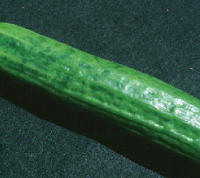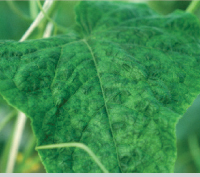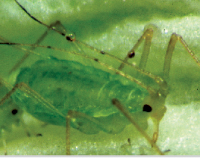
Features
Crop Protection
Inputs
Greenhouse Grower Notes: Virus activity heating up
September 2, 2008 By Gillian Ferguson
Cooler late summer and early fall temperatures mean aphids are becoming more active within the crop
The fall months are approaching and this time of year is almost synonymous with virus diseases. This is because aphids are particularly active during late summer and early fall when temperatures have cooled down somewhat and are more favourable for their activity.
More plant viruses are transmitted by aphids than by any other group of insects. For example, the green peach aphid, an extremely efficient insect vector, transmits at least 50 different plant viruses. In greenhouse cucumbers, cotton aphids are the most commonly occurring species, and some of the viruses they can spread in this crop include cucumber mosaic virus (CMV) (Figs. 1 and 2), water-melon mosaic virus (WMV), zucchini yellow mosaic virus (ZYMV), and papaya ringspot virus (PRSV). In greenhouse peppers, the green peach aphid is very common, and it may vector viruses such as tobacco etch virus (TEV).
Some of the reasons for efficient virus spread by aphids and difficulty in managing the diseases they cause include:
Similarly wide host range for aphids and viruses.
Production of winged forms.
Efficient spread of virus by aphids.
Lag time in effect of controls.
 |
| Fig. 1 – Cucumber fruit showing symptoms of cucumber mosaic virus. Photos courtesy Gillian Ferguson, OMAFRA |
 |
| Fig. 2 – Cucumber leaf showing symptoms of cucumber mosaic virus. |

|
| Fig. 3 – Aphid with piercing mouthpart or stylet probing plant surface. |
WIDE HOST RANGE OF HOST PLANTS
n Aphids and many disease-causing viruses share in common a wide range of host plants. For example, the green peach aphid is reported to feed and multiply on over 875 species of plants, including a wide variety of vegetable and ornamental crops, stone fruits, and weed species. Weeds play a particularly important role as reservoirs for viruses because they can overwinter in the roots of their weed hosts. Then when spring arrives, the virus goes to the top growth from which feeding aphids can acquire the virus. The most common virus that infects cucumbers and its relatives is CMV, and this has been found naturally occurring in at least 476 plant species; a further 536 species can become infected with this virus.
Winged Forms – Under greenhouse conditions, aphids multiply continuously and usually produce forms without wings. When conditions begin to deteriorate for them, such as during overcrowding and deterioration of food quality, aphids produce forms that have wings. It is these winged forms that contribute most to spread of virus diseases. In fact, the presence of a few winged aphids will do more to spread a virus disease than a large number of non-winged aphids that are stationary, feeding contentedly in one spot.
Efficient Vectors – Aphids transmit many viruses, for example CMV, in a non-persistent manner. This means that the aphid can quickly (10-30 seconds) pick up a virus from an infected plant, and just as quickly, infect a healthy plant while probing or making punctures to access plant sap (Fig. 3). Many non-persistent viruses occur predominantly in the epidermis or outermost layer of cells of the plant.
ONCE A SINGLE PLANT HAS BEEN INFECTED, FURTHER TRANSMISSION CAN BE CARRIED OUT MECHANICALLY
In general, aphids can transmit virus diseases in this manner for one or two hours. However, the more feeding punctures the aphid makes, the more quickly it loses its ability to infect other plants. Such transmission means that several plants can become infected without large numbers of aphids being visible. Once a single plant has been infected, further transmission can be carried out mechanically via activities, such as harvesting and pruning, that facilitate sap transmission.
Lag Time of Controls – Because of the lag time that exists between releases of biocontrols or application of control products, and kill of aphids, it’s very difficult to totally prevent virus spread. Studies indicate that protection of plants against virus infection by insecticides, whether contact or systemic, is never 100 per cent. With contact insecticides, new growth is not protected.
To counter this, if more frequent insecticide applications are made, resistance would quickly develop.
With systemic insecticides, because the aphids must feed to access the toxin in the phloem, they unavoidably become infected in the process. Such infected aphids can then go on to infect a few more plants before dying, unless the insecticide kills almost instantly. If the insecticide causes irritation and kills slowly, then the insect may move about more, and consequently, spread the virus to more plants. Other insecticides may have repellent or anti-feeding effects, and these have been demonstrated to reduce virus spread by reducing feeding activities.
MANAGEMENT STRATEGIES
Management of aphid-transmitted viruses in greenhouse crops requires an integrated approach that uses all available strategies. The first and basic strategy is to eliminate or at least reduce the source of the virus.
Reducing the source means meticulous control of weeds in and around the greenhouse; and not just weeds, but any other type of plant that could serve as a host for both aphids and viruses. Within the greenhouse, infected plants should be immediately removed upon detection.
Use of both biological and chemical controls can help in suppressing aphid populations and it is especially important to achieve early control to prevent the development of winged forms. An additional strategy is to carry out all activities in infected areas last, even after infected plants have been removed. This approach is necessary because infected plants may not show symptoms for about two weeks after infection. If possible, the optimal strategy would be use of cultivars that are resistant or tolerant to viruses.
Finally, sanitation is key to reducing spread, and measures such as disinfection of tools between plants or at least at the end of rows, can assist in this regard.
Gillian Ferguson is the greenhouse vegetable IPM specialist with the Ontario Ministry of Agriculture, Food and Rural Affairs in Harrow.
• 519-738-1258, or gillian.ferguson@ontario.ca
Print this page